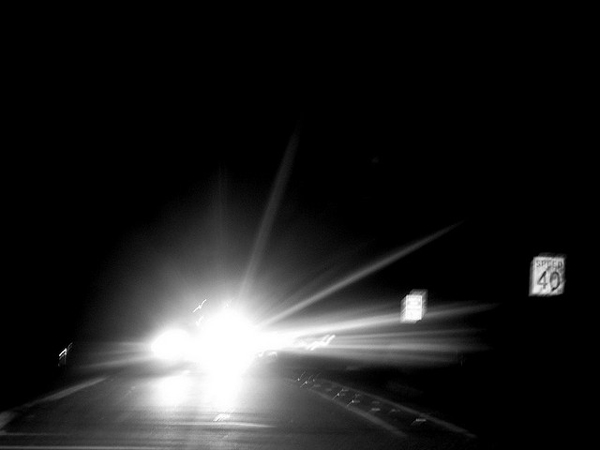
High-intensity headlights are popular and getting more so, especially here in Alaska during the long, dark winter months. They’re called “moose lights,” because they help drivers see farther down the road than conventional headlights to spot animals and other hazards. But Alaska State Troopers say moose lights can also create a hazard by temporarily blinding oncoming motorists in the other lane.
Ben Knix works at the NAPA auto parts store in Delta Junction, and he says he likes the added visibility he gets with his Light Force 240 high-intensity discharge lights he’s got mounted on his pickup’s rollbar.
“Yeah, I mean I have them just to see more moose, and anything else you might encounter while driving,” he said. “And they do really great. I like ’em.”
Knix says the bright lights also are popular among his customers.
“Y’know, we do sell a lot of them,” he said. “A lot of people like ’em.”
But Dave Slater says those extremely bright headlights really bother him.
“These brights are so bright – I mean, they’re even brighter than regular, standard-beam bulbs on high,” Slater said. “And they’re blinding.”
That’s what worries Sgt. Jess Carson, with the Alaska State Troopers’ Fairbanks Bureau of Highway Patrol office. Carson says Troopers have been getting a half-dozen or so complaints like Slater’s annually over the past few years. But he says they can’t really do much more than sympathize with them.
“We just explain to them that we share their frustration,” he said. “We understand that it is very difficult to see around them. That it limits your vision while you’re passing them, when you’re next to them and then for a little ways after you pass them. It’s almost the equivalent of somebody pointing a high-output flashlight in your eyes. It takes a little while for your eyes to adjust after that.”
Carson says there are no state laws or regulations that set standards on those after-market lights and fixtures – nor any that authorize enforcement.
“The current laws in Alaska don’t have any statutes that would allow us to enforce it.”
He says federal regulations set some standards. But they mainly govern the types of headlights that auto manufacturers install.
“What happens is people add after-market lights to the vehicles,” he said. “And that’s where we’re running into the problems.”
Carson says the federal regs also apply to the colors of light emitted by after-market units. But only those that that emit greenish or yellowish colors. Not the bright blue-ish light that many complain of – but which the federal regs classify as white-ish.
“When you see the blue lights out there, although our eye picks up some blue, it still falls within the white spectrum,” he said.
Carson says headlight systems that manufacturers install in vehicles have been tested and certified as safest for all motorists. He says they provide enough light for drivers to see a safe distance ahead, while still allowing those in the oncoming lane to preserve their night vision.
He says that’s the balance that the federal regs seek to maintain – the balance that’s thrown out-of-whack by extremely bright headlights.
“The light is designed for the maximum output for the individual behind the wheel. And you have to run a happy medium there of your ability to see versus what you’re causing to other vehicles around you.”
Carson says that’s the basis of his counter-argument to those who say moose lights make driving safer: that those bright lights can blind the other drivers, causing them to hit the ditch – or an oncoming vehicle.
“So, although you’re able to see moose, you’re able to see a little farther, you’ve now put a several-ton piece of metal flying at you at 55 miles an hour, and ruin their ability to see their lane anymore,” he said.
Carson says unless and until motorists decide something needs to be done about extremely bright headlights, and get legislators to pass laws to regulate them, Troopers can’t do much about them – unless they happen to be nearby and see a motorist failing to dim them.
Slater, who complained about the bright headlights in a letter to the editor of the Fairbanks Daily News-Miner, says he’s not arguing in support any sort of legislation. He says he’s just trying to point out the need for motorists to think of the other guy in the oncoming vehicle.
“Y’know I hate to have a new law imposed on people,” he said. “I would rather it be something that people just do out of courtesy to their fellow man.”
And on that point, both Carson and Knix, the auto-parts store worker, agree.
Tim Ellis is a reporter at KUAC in Fairbanks.




